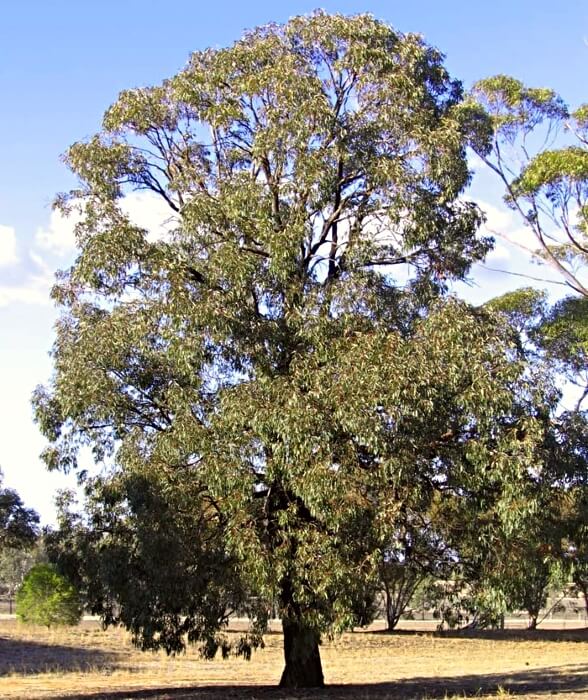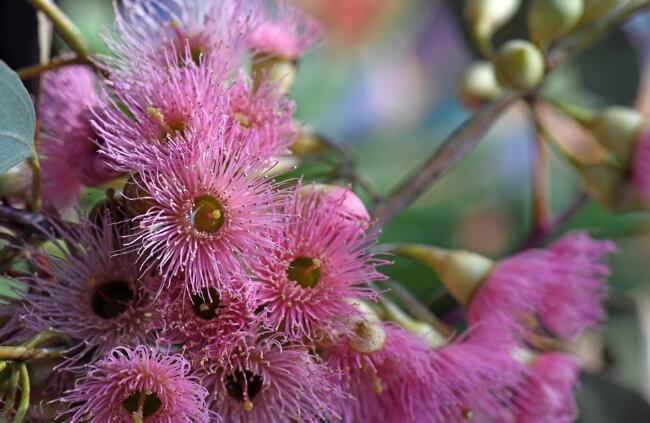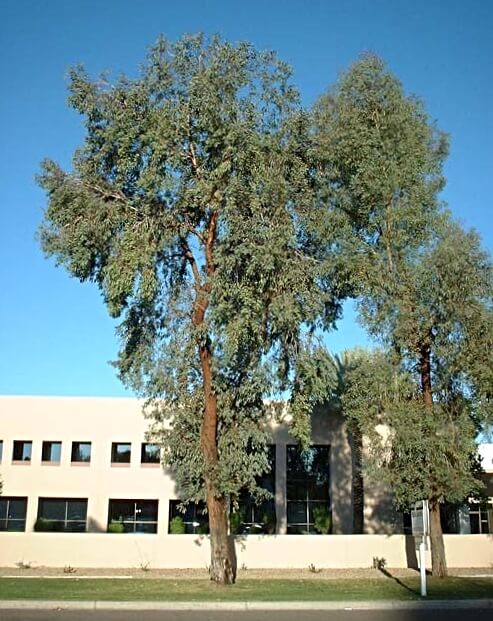Eucalyptus sideroxylon, like most natives, are generally overlooked. They’re common as muck and tend to be well-established in their landscapes before they are noticed. But, step back for a moment and look more closely, because these are some truly, stunningly, detailed plants.
The foliage of red ironbark is pale, pastel green. Mature growth is deeper, richer. But in spring, new growth shows off its incredible colouring, with vivid red leaf borers, coupled with bright blood-red new growth, before they thicken and join the trunk as a smooth, warmly coloured, deeply ridged tree.
If my enthusiasm for these plants hasn’t enticed you, then perhaps the promise of an in-depth growing guide might, because that’s what’s coming up.
More...

Source: The Native Shop
Family: | Myrtaceae |
|---|---|
Genus: | Eucalyptus |
Species: | E. sideroxylon |
Origin: | Australia |
Common names: | Red ironbark or Mugga ironbark |
Location: | Outdoor |
Type: | Tree |
Growth: | Up to 30m, typically 20m in gardens and open spaces |
Sun requirements: | Full sun, tolerates light shade |
Foliage colour: | Pale green |
Flower colour: | Pink and red |
Flowering: | Autumn to early summer |
Edible parts: | None |
Maintenance level: | Low |
Poisonous for pets: | All parts are toxic to cats and dogs |
What is Eucalyptus sideroxylon?
Eucalyptus sideroxylon is a common native ironbark that grows to around 30m tall. This medium-sized, evergreen tree has highly scented foliage and deeply textured bark, as well as colourful foliage, and gorgeous flowers which make it an ideal specimen tree for gardens all over the country.
Its flowers come in both red and pink forms, with the red form sometimes sold as Eucalyptus sideroxylon ‘Rosea’.
While it is seen as invasive in other countries, there are very few reports of it causing a nuisance around Australia, where it is typically outcompeted by taller species, rather than the other way around.
With year-round flowers, sometimes right into summer, Eucalyptus sideroxylon, also called red ironbark or the mugga ironbark is a wonderful wildlife tree, both for nesting and feeding birds at all times of year, thanks to its nectar-rich, petalless flowers, which are accessible to all types of birds and insects.

Mugga Ironbark’s Natural Habitat
Eucalyptus sideroxylon has a diverse native range, from Queensland to Victoria, and is common throughout New South Wales too. Other than the subspecies improcera, which is found only in Barakula State Forest, all subspecies are found dispersed around Southern and Eastern Australia.
They are particularly abundant in woodlands, both on woodland edges, and within the woodland itself, where they are capable of growing through canopies and withstanding exposed conditions in equal measure.
Common uses for Eucalyptus sideroxylon
Eucalyptus sideroxylon is one of the least used eucalyptus trees for medicinal purposes. This is entirely down to it having low concentrations of eucalyptol and other essential oils that make it useful.
Where it is used in treatments and cold remedies it is generally mixed with eucalyptus leaves from high oil-yielding trees, like blue mallee or Eucalyptus globulus.
Where it comes into its own is through its timber, which has natural compounds that protect it against rot. These compounds are just as useful in the harvested wood as they are in the living trees, and in both cases, they protect against rot.
Polyphenols (in particular; stilbenoids and ellagitannins) are found in extraordinarily high concentrations, making these trees incredibly resilient, and excellent additions to landscape schemes and parks.
Eucalyptus sideroxylon subspecies
While much is made of the flower colour’s variations, which can be cream, pink, white or red, Eucalyptus sideroxylon actually has very few variations, and plants pollinated by the same parents can produce flowers of very different colours.
We’ll come onto how you, as gardeners, can adapt and amend propagation to account for this later, but for now, it’s worth noting that species and subspecies do not necessarily define the colour of the eventual flower on Eucalyptus sideroxylon.
There are just two subspecies of Eucalyptus sideroxylon accepted by the Australian Plant Census:
Eucalyptus sideroxylon subsp. improcera
Eucalyptus sideroxylon subsp. improcera shared every characteristic with its parent, from the leaf shape and distribution to the bark structure and seed capsules. However, it grows a maximum of 10m tall, just half the height of its cousin.
Eucalyptus sideroxylon subsp. sideroxylon
The standard subspecies, named for classification purposes, is the same tree as the main subject of this article. It grows to a usual height of 20m but can reach 30m in some cases.
How to Grow Eucalyptus sideroxylon
In gardens, this Eucalyptus species generally grows to around 20m tall. If grown in open space, with full sun, it can become a wonderfully structured tree, with twisting branches that host a dappled fluffy of foliage.
Achieving that yourself is surprisingly simple, as we will explore in the growing guide for red ironbark below.

Source: Merri-bek City Council
Ideal Conditions for Growing Mugga Ironbark
When planting a young Eucalyptus sideroxylon at home, aim for somewhere in bright, full sun, and with well-drained soil. Avoid highly exposed windy spots if you can, or plant the shorter subspecies improcera to mitigate the risk.
Note that the shallow surface roots can lift paving, but will not usually break concrete. Avoid planting near pools or pathways if you can.
Soil & Drainage
Eucalyptus trees are usually quite tolerant of different soil types, and for the most part, E. sideroxylon shares that trait. Apart from one key factor: drainage.
This Eucalyptus species absolutely 100%, requires good drainage. It won’t tolerate sodden ground, and boggy or slow-drained soils are out of the question.
When planted in heavy clay its leaves can turn yellow, and growth becomes weak very quickly during wet seasons. So, stick to well-drained loam, or sandy soils.
It does prefer slightly acidic soils, but provided it isn’t strongly alkaline, it will be quite happy. Well-drained soil only but other considerations can vary – all types provided well-drained.
Light & Temperature
This Eucalyptus species can survive temperatures right down to -9°C for short snaps and is completely drought tolerant. Full sun is close to essential, but it will grow in dappled light if you have nowhere else to put it.
Planting Eucalyptus sideroxylon
Before planting, clear the ground around it of weeds. It might be a tough tree, but it won’t enjoy competition, so the more deep-rooted weeds you can remove, the better. If planting into a lawn, dig a 1.5m circle around the planting hole so the lawn isn’t taking moisture as roots develop.
Once the area is cleared, dig a hole twice the width of the root ball, and equal to the root ball’s depth. Rub mycorrhizal fungi around the root ball to improve its initial relationship with the fungal networks in your soil, and speed up rooting.
Once you’re happy with the position and angle of the tree, fill the hole back in with a well-drained soil mix. Finally, heel the base of the tree firmly in place, and water thoroughly, before adding a final layer of mulch to lock that moisture in.
How to Propagate Red Ironbark
Red and pink flowers are both sought after for different reasons with Eucalyptus sideroxylon, both neither is genetically different from the other, so it is essential to grow by grafting or by taking cuttings to propagate plants with identical flowers to their parents.
Seeds will germinate readily, but without any guarantee of the flower colour, regardless of how it was pollinated.
As with all Eucalyptus propagation, seedlings are the most convenient, and cuttings rarely strike successfully, but are well worth trying if you are a home gardener and willing to fail in the name of horticulture.
Propagating from Seeds
The tiny seeds of Eucalyptus sideroxylon are hard to keep track of, so put down paper before you begin, whether you’re working with a packet of seeds or seeds taken from dried pods on a tree.
Set up your area with everything you need before getting your seeds out (they will inevitably get lost otherwise).
Start by preparing a tray of seed compost, using a sieved general-purpose compost, mixed with one-third of its volume in sand (3 parts soil:1 part sand). Wet the compost and let it drain.
Then sow the seeds directly onto the surface of the soil. Place the seed tray anywhere warm and bright for 1-2 months. Germination is usually slow and unreliable, but by sowing dozens of seeds at once, you are sure to have some success.
Watch out for germinated seeds, and don’t overwater them.
Propagating from Cuttings
Stem cuttings from coppiced ironbark are a much more reliable cutting material than stem cuttings from mature trees. The fresh, supple growth strikes far more easily in typical conditions.
Eucalypts of all types are difficult to root from cuttings because they do not lend themselves to the reassignment of cells that causes adventitious roots to form along the stem, or from the cut nodes.
However, this Eucalyptus species is widely reported to buck this trend when those cuttings are taken from coppiced growth in spring.
There are two options, but one is more reliable; Option 1 (less reliable) is to take the cutting from the removed coppice; Option 2 (more reliable) is to use the regrowth in mid to late spring and cutting material.
These fresh cuttings strike well in pots filled with pure perlite.
How to Care for Eucalyptus sideroxylon
Red ironbark takes very little care, but for statement trees planted in our gardens, there are some precautionary tips for keeping them looking their best.
Firstly though, take note of those garden tasks that will neither help nor hinder the growth of Eucalyptus sideroxylon. For example, there is no need for water, even through droughts. This is a completely drought-tolerant tree, and overwatering is far riskier than underwatering.
Next, avoid mulching or feeding after first planting your red ironbark tree. They require no additional fertiliser and are very happy to survive on limited nutrients even from very poor soil.
Pruning Eucalyptus sideroxylon
It is, however, important to prune mature trees every few years. Avoid letting them develop very heavy branches, as they are quite susceptible to snapping with wind damage, and can fall during bad storms.
This isn’t as important for multi-stemmed trees, and not at all important for pollarded or coppiced ironbarks. If coppicing, cut back either annually or biennially to maintain good height, and allow your eucalyptus time to recover.
Common Eucalyptus sideroxylon Problems
In some ways, Eucalyptus sideroxylon, like all eucalypts and myrtles, can be a useful pest deterrent. It helps to prevent mosquitoes and is useful to have around to rub over bites or stings too.
However, despite its ability to prevent rot through its own wood, it is susceptible to quite a few common eucalyptus pests. Diseases, as you might expect, thanks to its in-built defences, are few and far between, but root rots and blights caused mostly by overwatering do occur.
Get to know the signs and symptoms of the most common red ironbark growing problems below.
Eucalyptus sideroxylon Pests
Pests of Eucalyptus sideroxylon include stem borers, weevils, caterpillars, call wasps and psyllids, as well as many common garden pests like aphids and mites.
Stem borers
Stem borers are problematic, but the self-defence mechanisms of red ironbark do mean that the stem borers, other than weakening the physical structure of the trees, generally don’t cause rotting infections.
Signs include piles of sawdust either around the base of the tree or trapped in the deep grooves of the bark. Treatment can include the introduction of natural predators, or spraying neem directly into the active boreholes.
Weevils
Weevils cost the eucalyptus timber industry in Australia millions each year. If that doesn’t put their potential damage through defoliation into perspective I’m not sure what will. These pesky pests have a voracious appetite and are hard to get rid of.
In mature trees, birds and other wildlife pick them off, but young trees and coppiced eucalyptus require a more hands-on approach.
Caterpillars
Several species of caterpillars have a taste for eucalyptus. Two in particular, the emperor gum moth, and the gum leaf skeletoniser moth, lay their eggs onto the leaves of Eucalyptus sideroxylon, causing heavy defoliation of young trees.
On mature trees, the damage is minimal and rarely causes a problem.
Gall wasps
Gall wasps are damaging to young trees, and unsightly on coppiced red ironbark. Thankfully though, their presence is easily controlled by the removal of affected leaves, and regular sweeping of fallen leaves to prevent recurrence.
They are fairly easy to spot, as the leaves look like they have developed rust fungus, but rather than orange, the galls are grey.
Eucalyptus sideroxylon Diseases
Eucalyptus sideroxylon shows resistance to Texas root rot and verticillium amongst other common garden problems, but remains susceptible to chlorosis, phytophthora and root rot.
Chlorosis
Chlorosis tends not to affect mature Eucalyptus sideroxylon trees, but it might following a flood. Chlorosis is caused by overwatering-induced root damage, where standing water prevents roots from processing nutrient uptake.
It isn’t a disease in itself but is indicative of other problems – usually root rot.
Root Rot
Oak root rot, phytophthora, and several other common fungal problems and root diseases cause what is generally referred to as root rot. The results begin with signs of chlorosis in most cases, and progress to defoliation, slow recovery times, and sometimes quite rapid dieback of sections of a tree.
Treatment varies depending on the specific cause and can range from repotting young trees to chemical treatments, or removing the entire tree and replacing the soil in extreme cases.
Mugga Ironbark Frequently Asked Questions

Source: OzNativePlants
What is Eucalyptus sideroxylon used for?
Eucalyptus is a dense, reliable hardwood, used for everything from boat building to railway sleepers. Its leaves have limited fragrance so it is generally mixed with other species or used as a filler in medicinal uses.
Is Eucalyptus sideroxylon ‘Rosea’ poisonous?
Eucalyptus sideroxylon ‘Rosea’ is poisonous in large amounts to pets and humans. On skin, it can cause severe rashes and even blisters.
What is the common name for Eucalyptus sideroxylon?
The common names for E. sideroxylon include red ironbark and mugga ironbark. Both are old names for the tree, but Mugga is the aboriginal name for the tree. Red ironbark simply describes its foliage and flower.
How do you identify Eucalyptus sideroxylon?
The most recognisable and distinguishable characteristic of E. sideroxylon is its deep ridges, that carry on up the trunk and mature branches, while the younger branches are smooth, grey or brown.
How tall does Eucalyptus sideroxylon grow?
Red ironbark, E. sideroxylon, grows to a mature height of around 35m but usually sticks to 20m in open gardens where it isn’t competing for light.
Is Eucalyptus sideroxylon invasive?
E. sideroxylon is not an invasive species through Australia, but is invasive in South Africa, and potentially parts of the Americas. It is tolerant of frost and drought, making it well-adapted to other climates.
Does Eucalyptus sideroxylon have invasive roots?
E. sideroxylon should always be planted at least 5m, if not 10m, away from pipes or foundations. Its roots are unlikely to break through hard landscaping, but they are shallow and will lift paths, so avoid planting near structures where possible.
How hard is red ironbark?
Red ironbark is one of the most durable timbers grown in Australia. Its wood is extremely hard and resistant to rot, with interlocking grains and a coarse texture, creating an incredibly durable timber.
What is the difference between red ironbark and grey ironbark?
Aside from the obvious colour differences, the difference between red ironbark and grey ironbark is minimal. As trees, they are quite different, but as timber, they are interchangeable. Personally, I think red ironbark has a significant visual edge.
What is red ironbark timber good for?
Red ironbark is used for everything from piles and pillars to marine construction and bridge building. It is a reliable, rot-resistant timber that lasts, and lasts, and lasts.
Bring the Rugged Charm of Eucalyptus sideroxylon to Your Garden
Red ironbark, or mugga ironbark to some of us, is a wonderful building material, but an even better tree. While its use throughout Australia is often limited to its appeal as a hardwood, it really does deserve more consideration in our gardens and parks, where it’s just as beautiful up close as it is from a distance.
If you’re considering growing Eucalyptus sideroxylon at home, make sure you’ve got enough space for it, or work out how and where to plant a coppiced screen for a less fragrant alternative to a typical eucalyptus hedge.
Published on February 1, 2024 by Nathan Schwartz
Last Updated on March 4, 2024





